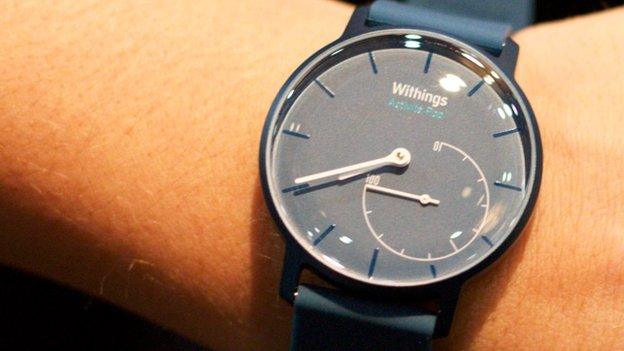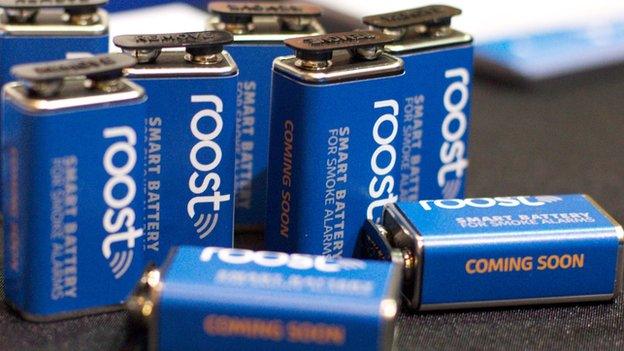CES 2015: More picks from the floor
- Published

CES Unveiled is a pre-event for reporters and industry figures to take an early look at some exhibits
There are an awful lot of gimmicks at the Consumer Electronic Show's teaser event.
More than 100 companies paid for the privilege of showing off their wares on Sunday, two days ahead of the giant Las Vegas tech show getting under way.
But while many of the products at CES Unveiled may soon fade from memory, three did stand out.
Not necessarily because they will be best-sellers, but rather because of what they represent.
In no particular order, here are some of the more interesting gadgets on show at Unveiled:

Withings Activite Pop

CES organisers say the conference centre floor dedicated to smartwatches will be four times the size at this year's event compared with 2014's.
The suspicion is that most won't appear as "traditional" as French company Withings' latest offering.
The Activite Pop is a cheaper, more colourful version of the Activite timepiece released by the firm just weeks ago.
Like its more expensive sibling, the watch eschews a digital readout in favour of two analogue hand dials - one showing the time, the other how close the wearer is to their footsteps goal for the day. The device is powered by a battery that should last eight months before needing to be replaced. The tech inside can also track the owner's sleep patterns and estimate the number of calories they have burned, but relies on an associated smartphone app to provide feedback.
The Pop lacks the "Swiss Made" branding of the original Activite and looks and feels a less "premium" option, but critically it is one-third of the cost at $150 (£98), which might tempt those concerned at splashing out on a device that's guaranteed to be superseded by a thinner, more advanced version in a year or two.
"A lot of people abandon their activity trackers after a few months because it's something they have to take off and charge and it's not familiar to them - they tend to lose them or forget to put them back on," says Ariel Carpenter, marketing manager at the French firm, which also sells such dedicated kit.
"This is something that they have known for many years."
Of course, Withings lacks the brand power of Apple, Samsung, Motorola, LG and the other big tech firms diving into the smartwatch sector, and that will inevitably limit the Pop's chances.
But it represents an alternative to the touchscreen, app-centric approach of those rivals. And as we await the entry of traditional watchmakers such as Fossil, Swatch and others into the sector, perhaps it signals that appealing smartwatch designs don't need to come across like smartphones shrunk to suit our wrists.

Tobii SteelSeries

The light circle indicates where on the screen the gamer is currently looking
Eye-tracking specialist Tobii is a CES regular, and has been promising to change the way consumers interact with computers for years.
Now - at least for a niche audience - it is finally delivering on that promise.
A tie-up with gaming peripheral manufacturer SteelSeries has delivered the Sentry - a piece of kit that allows video players to review where they were looking at on the computer screen during gameplay of popular eSports titles League of Legends and Starcraft, as well as providing them with associated statistics.
In addition, gamers can provide video streams of their activity over Amazon's Twitch service that allow their spectators to see exactly what they are looking at as they battle virtual enemies.
"This gives the audience a much richer experience, as suddenly you can see not only where the guy clicks but also see what he is interested in, and almost anticipate his next move," explains Oscar Werner, Tobii's president.
"By seeing what pro-gamers are looking at, you can learn how they think."
With universities starting to offer eSports scholarships, and prize money for the activity on the rise there is likely to be quite a bit of interest in the new kit among the gaming community.
Whether all the elite players will be willing to share access to the inner workings of their minds is another matter.

Roost

They look boring - but these smart batteries have some very useful applications
Of all the tech on show at CES Unveiled, Roost probably looked the least exciting at first glance - a nine-volt rectangular battery distinguished only by a bit of branding on its side declaring "coming soon".
The idea behind it, however, is rather clever.
If you install the product in a smoke detector it makes the kit "smart" by sending notifications to the homeowner's smartphone via wi-fi if the machine's alarm has been triggered. It does this by using a sensor that listens out for the sound of the alarm's wail - potentially helpful if you're not in the property at the time. In addition, it sends a message to tell you if the battery needs changing before the smoke alarm starts its annoying chirp.
"It's a different approach to what everyone else is taking to the smart home," explains David Henry, chief marketing officer at the start-up.
"We're taking a retrofit approach. Our mantra is low-cost affordability that is easy to install."
The product costs about $35 (£23) and should last about five years. Even then, only part of it needs to be replaced, meaning that for a $10 charge the kit can be re-used.
Google's Nest division makes the Protect - a more advanced internet-connected smoke detector that has become one of the poster childs of the smart home sector. But the truth is that despite there being a huge fuss about the idea of making us buy new, cleverer versions of our home appliances, most households have proved resistant to the idea, not least because of the costs involved.
Perhaps adapting existing tech at a fraction of the price will have more appeal for those wishing to dip their toes in the waters.
Roost certainly hopes so. Having raised close to $10,000 on Kickstarter for its smart battery, the firm is now exploring what other household kit it can link up to the net. CES 2015: Highlights at the Unveiled curtain raiser
Click here for more coverage from the BBC at CES 2015, external